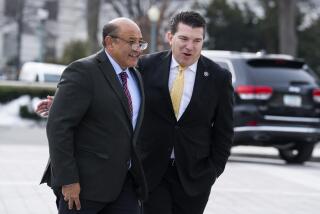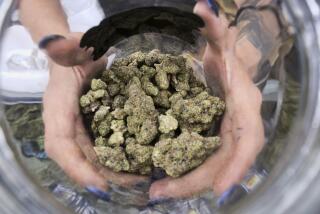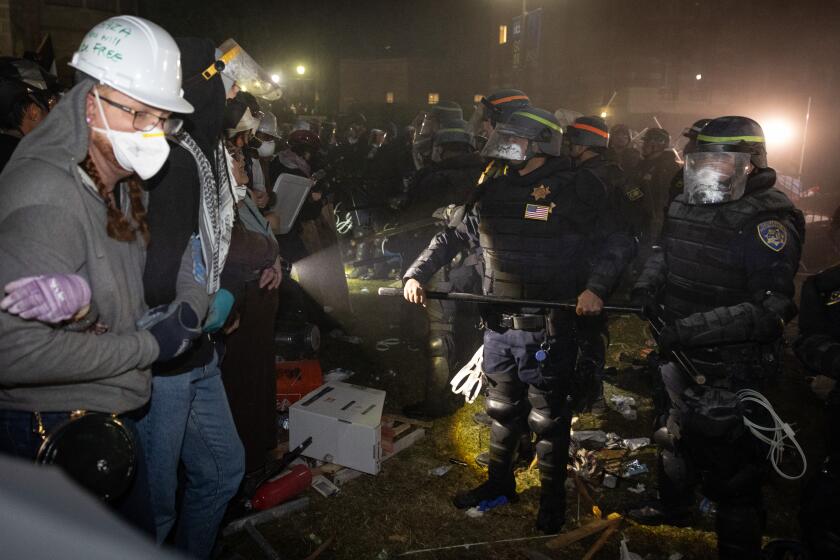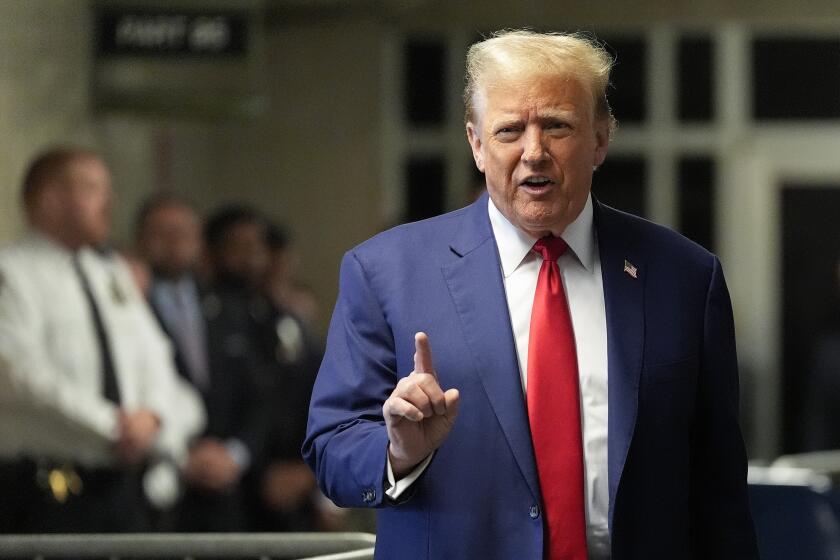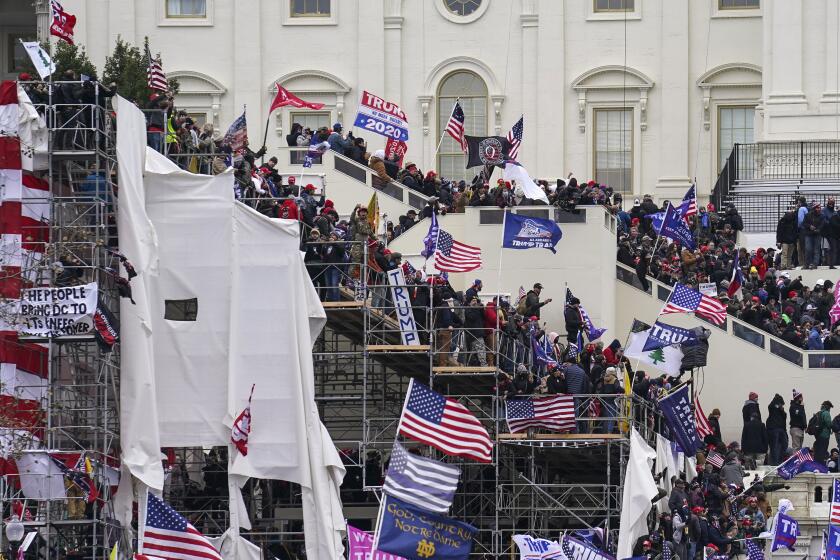From Pew to Politics : Evangelicals Reveal How Many See America
A sultry September evening in the Los Angeles basin, 1926. The throng is gathering at the huge Trinity Methodist Church to hear the inspiring Paul Rader, one of the vastly popular evangelists of the time.
Among them is a father and his three boys. He has taken the family before to hear the perspiring, throaty sermons of Billy Sunday, and his own wife has been “saved” in a revival as a young girl.
But now he is seeking the spur of fire and brimstone, the comfort and fevered salvation, all the more in the latest wave of evangelism sweeping the country. They are all still grieving at the sudden, mysterious death in the past year of a fourth and youngest son. A fierce worker trying to prove himself, especially to his wife’s frowning family, the father sees God’s punishment in the tragedy and, in penitence, even closes his small business on Sundays.
They are part of the plain, ordinary folks whose little Fords crowded the parking spaces around the revival tents and temples, and whose devotion in money give the evangelists their formidable social and political power along with religious authority. Like the father and his boys, they are “mostly lower-middle class people,” writes one observer, “small shopkeepers, barbers, beauty-parlor operators, small-fry realtors, and the owners of hamburger joints . . . the uprooted, unhappy, dispirited lumpen proletariat.”
But tonight they are going to forget, for a while at least, their individual agonies and powerlessness, their resentments and doubts. On Rader’s command, the wide-eyed, sometimes wailing and almost frantic crowd will leap to its feet and surge down the isles for the cleansing salvation. “We joined hundreds of others that night,” one of the father’s boys will write about the moment, “in making our personal commitments to Christ and Christian service.”
In 1987, as in that humid night over 60 years ago, the now-subtle, now-sensational influence of evangelical Christianity is so much a force in American life and politics. There is, of course, the comely Jessica Hahn testifying before a federal grand jury in the continuing scandal of Jim and Tammy Bakker and the PTL ministry. And the Rev. Pat Robertson, making a strong showing in the latest straw poll in Iowa, is recognized as a real contender for the 1988 Republican presidential nomination. And, not least, the more hidden but fateful impact of his fundamentalist upbringing on former Democratic front runner Gary Hart, whose politically lethal peccadillo with model Donna Rice seems to have been part of a recurring drive to break out of his haunting religious past.
None of this is new, neither the circus nor the politics. In the 1920s, Aimee Semple McPherson--”Sister Aimee”--drove an ugly devil around the stage of her Angelus Temple, and took the lusty lead in a dramatized version of Sodom and Gomorrah before her scandal-ridden eclipse. Rev. Bob Shuler in his Blue Ridge drawl commanded one of the largest radio audiences in the world, and led successful campaigns to drive officials from office or to make the Bible compulsory reading in state schools and only narrowly missed being elected to the U.S. Senate.
Yet then as now, there has been a beguiling tendency in the media, and especially in serious political commentary, to treat it all as some passing curiosity, to cluck knowingly, sometimes to strike a kind of bemused contempt. The disturbing truth is that we know far too little about this vast, elemental force in our political midst, about how much and in what varied ways evangelical religion shapes the government, and the governors, of all of us. It is one thing to remain ignorant of the passions and purposes that inflame the Middle East or the Persian Gulf, another to misread the Iowa caucuses.
The reality is certainly far more than what burst to the surface, the money and corruption and sexual temptations of sweaty preachers. There is something profound in the yearning, and in the substantial contributions of low-income people, that stand behind a Pat Robertson’s candidacy, or, for that matter, in the moral fervor of much of Jesse Jackson’s constituency. In the 1980s no less than in the 1920s, a political pathology is evident in this easy transition from pew to political aspiration, telling us something important about how so many Americans really see their society and their system in the dark honesty of their spiritual fears and hopes. Already in this century, the compulsions of our moralism and righteousness have set the agendas for political inquisitions, for B-52 strikes on Cambodia, for Supreme Court majorities. Yet we stoutly, daintily refuse to examine the phenomenon with the seriousness and depth it obviously deserves.
I wonder if we know in this sophisticated complex world of micro-targeting for inter-continental missiles and super colliders, how much fundamentalist religion still determines policy, and the psyche of policy-makers. As social, political, even intellectual history, the evangelicals are in large measure who we are, and are becoming, as a nation. It will not do to look at them askance, like some freak show in an old Sinclair Lewis novel. The trouble with not knowing about what is really happening in those tents and temples, about who is standing next to you at the revival, is that we may be missing a past or future President of the United States.
Oh, yes, as for the father and his boys, they will go away this night in 1926 more than ever imbued with the zeal and inner fire. Thinking the principal of the local high school a secret smoker, the father sends his handsome oldest son far away to a Spartan religious school from which he soon returns with a raging case of tuberculosis, setting the scene for still more family tragedy.
Yet it is the middle boy, the 13 year old, who takes the religion and its message most seriously, and who will quietly apply it later in his own way. He too is sent away to school. And after a shaky start in public speaking class, he becomes something of a debater. He will go far beyond this emotional night of being saved, yet he never abandons the fierce self-righteousness of it all. His name is Richard Milhouse Nixon.
More to Read
Get the L.A. Times Politics newsletter
Deeply reported insights into legislation, politics and policy from Sacramento, Washington and beyond. In your inbox three times per week.
You may occasionally receive promotional content from the Los Angeles Times.
